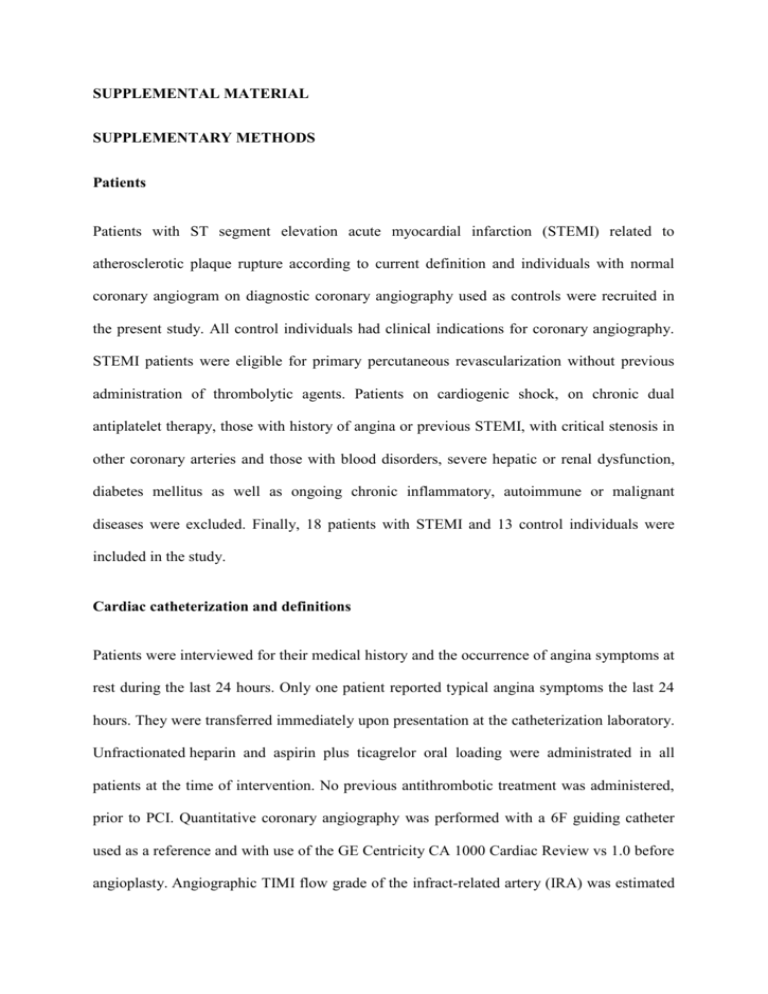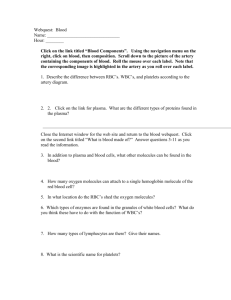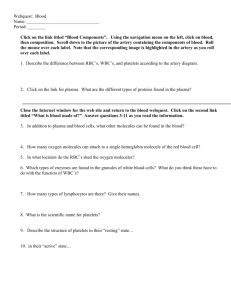Supplementary Data - European Heart Journal
advertisement

SUPPLEMENTAL MATERIAL SUPPLEMENTARY METHODS Patients Patients with ST segment elevation acute myocardial infarction (STEMI) related to atherosclerotic plaque rupture according to current definition and individuals with normal coronary angiogram on diagnostic coronary angiography used as controls were recruited in the present study. All control individuals had clinical indications for coronary angiography. STEMI patients were eligible for primary percutaneous revascularization without previous administration of thrombolytic agents. Patients on cardiogenic shock, on chronic dual antiplatelet therapy, those with history of angina or previous STEMI, with critical stenosis in other coronary arteries and those with blood disorders, severe hepatic or renal dysfunction, diabetes mellitus as well as ongoing chronic inflammatory, autoimmune or malignant diseases were excluded. Finally, 18 patients with STEMI and 13 control individuals were included in the study. Cardiac catheterization and definitions Patients were interviewed for their medical history and the occurrence of angina symptoms at rest during the last 24 hours. Only one patient reported typical angina symptoms the last 24 hours. They were transferred immediately upon presentation at the catheterization laboratory. Unfractionated heparin and aspirin plus ticagrelor oral loading were administrated in all patients at the time of intervention. No previous antithrombotic treatment was administered, prior to PCI. Quantitative coronary angiography was performed with a 6F guiding catheter used as a reference and with use of the GE Centricity CA 1000 Cardiac Review vs 1.0 before angioplasty. Angiographic TIMI flow grade of the infract-related artery (IRA) was estimated 1 according to four grades of flow (0-3) (Supplementary Table 1). The IRA was defined as the coronary artery that perfuses the area compatible with the distribution of ST-segment elevation in the 12-lead electrocardiogram. Spontaneous thrombus resolution in STEMI patients was defined as angiographic Thrombolysis In Myocardial Infarction (TIMI) flow grade 3 in the culprit vessel in first contrast injection before PCI, with significant (≥70%) cumulative ST-segment elevation resolution compared with the initial electrocardiogram and/or symptoms improvement.1 Sample collection Following wiring of the IRA, manual aspiration of thrombotic material and surrounding blood was performed with a heparinized dedicated catheter (Export® AP Aspiration Catheter, Medronic Vascular, USA). Blood samples from the non-infarct related (non-culprit) healthy vessels of STEMI patients (non-IRA) and from control individuals were obtained after coronary ostium engagement, through 6F diagnostic coronary catheters during primary PCI or diagnostic catheterization respectively. To assess whether the mode of blood collection affected the results, simultaneous sampling was performed through both the Export® AP Aspiration Catheter and the classic diagnostic catheters from the ascending aorta of healthy individuals (n=4) and the findings were compared. Overall the mode of sampling did not affect the results (NET-releasing neutrophils, neutrophil and platelet activation, MPO/DNA complex in plasma). Thrombi were transferred in formalin immediately and paraffinized within 48 hours. Blood samples from the IRA, the non-IRA of STEMI patients and from coronary arteries of control individuals were collected and used for isolation of PMNs and plasma within 30-45 minutes after the transfer to the catheterization laboratory. Plasma was collected immediately after centrifugation of blood obtained as previously, by heparinized catheter, at 1000x g for 10 min followed by centrifugation of the supernatant at 15.000x g for 2 15 min and stored at -80°C until analysis. All procedures for the collection and centrifugation of plasma were performed at 0°C. Platelets were also isolated immediately from platelet rich plasma (citrate blood centrifugation at 150x g for 10 min) by centrifugation at 600x g for 10 min. Platelets were resuspended in HEPES buffer and used immediately for analysis or in vitro stimulations. Stimulation and inhibition studies PMNs were isolated from arterial blood by double gradient centrifugation and were cultured in 5% CO2 at 37o C in RPMI (Gibco BRL) in the presence of 2% healthy donor serum. PMN purity and viability for all experiment was >98%. For in vitro studies PMNs from control individuals were treated with 6% plasma isolated from IRA, non-IRA blood of STEMI patients or arterial blood from control individuals for 3 hours. Furthermore, control PMNs were also incubated with platelets derived from citrate blood of IRA or non-IRA of STEMI patients or citrate blood of control individuals in a ratio of 1:50 for 3 hours. In vitro activated platelets were also used as a stimulus for control PMNs; control platelets isolated from citrate blood of control individuals were treated with 5% plasma (final concentration) isolated from IRA, non-IA blood of STEMI patients or arterial blood from control individuals for 30 min at 37oC. In another in vitro experimental set control platelets were also incubated with 5% control plasma treated with different NET structures. Platelets were always washed with HEPES buffer before introduced in PMN cultures. For the two-step stimulation of PMNs, platelets were pretreated with 5% IRA plasma from STEMI patients (activated platelets) for 30 min, washed with HEPES and introduced in PMN cultures in the presence or not of 6% IRA plasma from STEMI patients. 3 To block Protease-activated receptor 1 (PAR-1) signaling, platelets were pretreated with FLLRN peptide (500 mM, Anaspec) for 30 minutes. For thrombin inhibition, IRA plasma of STEMI patients was treated with antithrombin III or dabigatran for 30 min. Recombinant Thrombin (0.01U, Calbiochem) was used as positive control for control platelet stimulation. For the combined stimulation, dabigatran was used in both IRA plasma used for platelet activation and subsequent PMN stimulation. Immunofluorescence NETs generation, preparation and visualization by immunofluorescence confocal microscopy was performed as previously described.3, 4 Samples were stained using a mouse anti- myeloperoxidase (MPO) mAb (1/200 dilution, sc-52707, Santa Cruz Biotechnology Inc), a mouse anti- TF mAb (1/200 dilution, no.4509, clone VD8, Sekisui Diagnostics) or a rabbit anti-neutrophil elastase (NE) mAb (1/200 dilution, sc-25621, Santa Cruz Biotechnology Inc). An IgG1 anti-CD19 mAb (1/200, DAKO) was utilized as isotype control. A polyclonal rabbit anti-mouse Alexa fluor 488 antibody or a polyclonal goat anti-rabbit Alexa fluor 647 (1/300 dilution, Invitrogen) were utilized as secondary antibodies. DAPI (Sigma-Aldrich) was used for DNA counterstaining. Visualization was performed in a confocal microscope (Spinning Disk Andor Revolution Confocal System, Ireland) in a PLAPON 606O/TIRFM-SP, NA 1.45 and UPLSAPO 100XO, NA 1.4 objectives (Olympus). The percentage of NET releasing cells was determined by examining 200 cells in a double-blind experimental procedure. Sections of thrombus material derived from thrombotic coronary arteries of STEMI patients (4μm thickness) were deparaffinized and stained with anti-NE (1/200 dilution, Santa Cruz Biotechnology Inc), anti-citrullinated H3 (R2+R8+R17) (1/200 dilution, ab5103, Abcam), anti-MPO (1/200 dilution, DAKO) or anti-TF (1/200 dilution, Sekisui Diagnostics) antibodies. Sections were counterstained with DAPI and visualized in confocal microscope. 4 NET structures generation and isolation NET structures were isolated as previously described.5 In brief, 1.5x106 ex vivo or in vitrostimulated neutrophils were left in culture for 4 hours. Afterwards, the medium was removed and cells were washed with RPMI. 2 ml RPMI was added to each well and NETs were collected on supernatant medium after vigorous agitation. The medium was centrifuged at 20x g for 5 min and supernatant phase, containing NETs, was collected and stored at -20°C until use. Extracellular DNA, as an indirect marker of NET formation, was measured using Sytox Green (5 μM, Invitrogen) in a fluorescence microplate reader. NET structures were also collected from untreated control PMNs that undergo spontaneous NET generation in a percentage of about 3%. These very low concentration NET structures were used as a vehicle control (appear as control NET structures in manuscript and figures). NET protein isolation NET proteins were isolated as previously described.6 In brief,1.5x106 PMNs were seeded in 6-well culture plates (Corning Incorporated) in RPMI and left for 3 hours at 37oC in 5% CO2 (ex vivo) or in the presence of stimuli (in vitro). Supernatant was removed and each well was washed with pre-warmed RPMI. NETs were then digested with 10U/ml DNase-1 (Fermentas, 798 Cromwell Park, USA) for 20 min at 37oC. Ethylenediaminetetraacetic acid (EDTA; 5mM, Applichem, GmbH, Stockholm, Sweden) was used to stop DNAse I activity. Samples were then centrifuged at 300x g to remove whole cells and 16,000x g to remove debris. Proteins were isolated by precipitation with the addition of acetone overnight at -20oC followed by centrifugation at 14,000x g. MPO/DNA complex ELISA 5 To quantify NET release by ex vivo or in vitro-stimulated PMNs, MPO/DNA complex was measured in NET structures isolated from 1.5x106 PMNs as previously described7 or in plasma from patients with STEMI and control individuals. NET release was depicted as % increase compared to controls. Western blot analysis Immunoblotting for TF determination was performed as previously described.4 In brief, for detection of TF a goat anti-human TF polyclonal antibody (1/1000 dilution, no.4501, Sekisui Diagnostics) was used. For GAPDH, a rabbit anti-human GAPDH polyclonal antibody (1/3000 dilution, 2275-PC-100, Trevigen) was used. RNA isolation, cDNA synthesis and quantitative real-time polymerase chain reaction RNA isolation, cDNA synthesis and real-time qRT-PCR for TF were conducted in PMNs, as previously described.4 FACS analysis After isolation and in vitro stimulations, platelets were stained for surface activation markers with anti-CD62P-PE antibody (IM1759U, Beckman Coulter, Switzerland) and annexin VFITC antibody (BD Biosciences). Anti-CD61-PerCP antibody (347407, BD Biosciences) was used as a platelet specific marker. Platelets were immediately diluted in 500μl of HEPES buffer and analyzed by flow cytometry (BD Biosciences, FACScan). Analyses were performed on 104 gated CD61 positive events in Cell Quest program (BD Biosciences). For PMNs, anti-CD61-FITC (BD Biosciences) was used as a marker of PMN/platelet aggregation. Anti-CD66b-PerCP (305108, Biolegend) was used as a PMN specific marker. 6 Analyses were performed on 104 gated CD66b positive events in Cell Quest program (BD Biosciences). Intracellular staining for TF was performed as previously described.8 PMNs were identified as CD66b positive events. TAT complex ELISA assay Thrombin concentration was measured in ex vivo plasma obtained from blood of IRA, nonIRA of patients with STEMI or control individuals. TAT complex was further studied in control plasma isolated from control individuals which was stimulated in vitro with NET structures. NET structures isolated from PMNs were introduced in plasma in a final concentration of 20% and incubation was performed for 10min at 37o C. After incubation, plasma was immediately transferred in ice to stop further thrombin activation. To test TFdependent thrombin generation, NET structures were pretreated with a neutralizing anti-TF antibody (Sekisui Diagnostics) before plasma stimulation. Moreover, chromatin scaffold was dismantled with DNase I treatment of NET structures for 30min at 37o C, prior to their introduction in the control plasma. The concentration of thrombin-antithrombin (TAT) complex was measured according to manufacturer’s instructions (Assaypro, Winfield, MO, USA). In vivo measurements are depicted as ng/ml while in vitro plasma stimulations are represented as percentage of increase compared to control. The minimum detectable concentration of the assay was 300 pg/ml. 7 SUPPLEMENTARY TABLES Supplementary Table 1. Characteristics of the study population STEMI Control P value N=18 N=13 Age, y 55±11 52±9 0.625 Gender, M/F 11/7 5/8 0.285 Left ventricular ejection fraction, % 48±10 60±5 <0.001 Minutes from pain to sampling 155±65 - - Creatinine, mg/dL 0.9±0.1 0.9±0.1 0.993 C-reactive protein, mg/dL 1.4±1.7 0.8±0.6 0.183 Hyperlipidemia, (n) 14 8 0.342 Hypertension, (n) 10 9 0.457 β-Blockers, (n) 5 3 0.777 Diuretics, (n) 3 3 0.669 ACE inhibitors, (n) 1 0 0.405 Statins, (n) 9 5 0.540 ARBs, (n) 7 5 0.982 Cigarette smoking (n) 12 6 0.268 Culprit vessel, (LAD / LCx / RCA) 12 / 2 / 4 - - Angiographic TIMI flow grade (3/2/1/0) 4/2/2/10 TIMI risk score 1.7±1.6 - - Therapy on admission LAD: left anterior descending artery, LCx: left circumflex artery, RCA: right coronary artery TIMI: Thrombolysis in Myocardial Infarction flow grade 8 SUPPLEMENTARY FIGURE LEGENDS Supplementary Figure 1. Coronary angiography frames from STEMI patients. Representative coronary angiography images derived during primary coronary intervention in patients with STEMI. Arrow indicates thrombus present in the lumen of the IRA. Arrowhead indicates the site of spontaneous thrombus resolution. 9 Supplementary Figure 2. TIMI flow doesn't correlate with NET release. Regression analysis of TIMI flow grade and MPO/DNA complex (as a marker of NET release) in IRA plasma from STEMI patients. P= 0.98 (non significant) 10 Supplementary Figure 3. PMNs are the main leukocyte cellular population in thrombi from patients with STEMI. A. Hematoxylin-eosin staining in thrombi derived from IRA of patients with STEMI. Thrombi were characterized by abundance of PMNs (over 90% of leukocytes present in the thrombi) which formed islets covering over 40% of the thrombus. Thrombi that underwent spontaneous resolution demonstrated very small number of leukocytes and PMNs specifically. Thrombi were visualized in light microscopy. Original magnification 100x and 400x. B. NETs visualized in thrombus specimens from patients with STEMI as extracellular structures decorated with MPO and NE compared to residual thrombus material from thrombi that underwent spontaneous thrombus resolution, as observed by confocal microscopy (z stack analysis, 0.3μm per plane). Green: MPO, Red: NE, Blue: DAPI/DNA. One representative out of nine independent experiments is shown. Original magnification 400x. Scale bar – 5μm. 11 Supplementary Figure 4. Intracellular TF expression in STEMI PMNs. TF expression in PMNs from IRA or non-IRA and control individual arteries as observed intracellularly with FACS analysis. One representative out of three independent experiments is shown. Mean fluorescence intensity (MFI) of flow cytometry analysis data (n=3) are presented as box chart (mean±SD). 12 Supplementary Figure 5. Comparison of TF localization on NETs. TF immunofluorescence on NETs in ex vivo IRA PMNs and control PMNs stimulated with PMA, as observed by confocal microscopy (z stack analysis, 0.3μm per plane). Green: TF, Red: NE, Blue: DAPI/DNA. One representative out of three independent experiments is shown. Original magnification 600x. Scale bar – 5μm. 13 Supplementary Figure 6. FACs analysis of ex vivo and in vitro activated platelets. Representative flow cytometry analysis of Annexin V (A) and CD62P (B) on platelets obtained by selective coronary sampling (control individual coronary artery platelets / ctrl art PLT, Infarct-related artery platelets / IRA PLT, non-infarct-related artery platelets / non-IRA PLT) and control platelets treated with plasma obtained from non-IRA or IRA in the presence of thrombin inhibitor, dabigatran. One representative out of four independent experiments is shown. 14 Supplementary References 1. Cohen M, Boiangiu C, Abidi M. Therapy for ST-segment elevation myocardial infarction patients who present late or are ineligible for reperfusion therapy. J Am Coll Cardiol. 2010;55(18):1895-1906 2. Savi P, Chong BH, Greinacher A, et al. Effect of fondaparinux on platelet activation in the presence of heparin-dependent antibodies: a blinded comparative multicenter study with unfractionated heparin. Blood. 2005;105(1):139-144. 3. Brinkmann V, Laube B, Abu Abed U, Goosmann C, Zychlinsky A. Neutrophil extracellular traps: how to generate and visualize them. J Vis Exp 2010;(36). pii: 1724. doi: 10.3791/1724. 4. Kambas K, Mitroulis I, Apostolidou E, et al. Autophagy mediates the delivery of thrombogenic tissue factor to neutrophil extracellular traps in human sepsis. PLoS One 2012;7:e45427. 5. Saffarzadeh M, Juenemann C, Queisser MA, Lochnit G, Barreto G, Galuska SP, Lohmeyer J, Preissner KT. Neutrophil extracellular traps directly induce epithelial and endothelial cell death: a predominant role of histones. PLoS One 2012;7(2): e32366. 6. Urban CF, Ermert D, Schmid M, Abu-Abed U, Goosmann C, Nacken W, Brinkmann V, Jungblut, PR, Zychlinsky A. Neutrophil extracellular traps contain calprotectin, a cytosolic protein complex involved in host defense against Candida albicans. PLoS Pathog 2009;5:e1000639. 7. Caudrillier A, Kessenbrock K, Gilliss BM, et al. Platelets induce neutrophil extracellular traps in transfusion-related acute lung injury. J Clin Invest 2012;122: 2661-2671. 8. Kambas K, Markiewski MM, Pneumatikos IA, Rafail SS, Theodorou V, Konstantonis D, Kourtzelis I, Doumas MN, Magotti P, Deangelis RA, Lambris JD, Ritis KD. C5a and TNF-alpha up-regulate the expression of tissue factor in intra-alveolar neutrophils of patients with the acute respiratory 2008;180(11):7368-7375. 15 distress syndrome. J Immunol.






